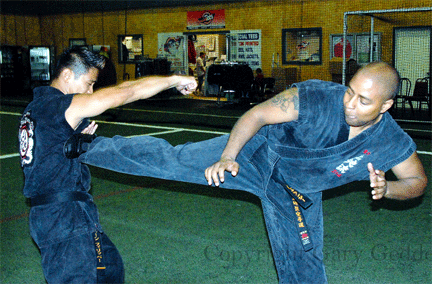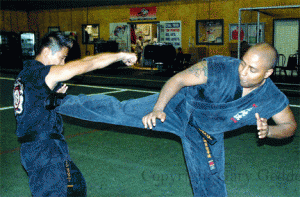Uechi Ryu Karate Do
Uechi Ryu Karate is a family style that comes from Okinawa but its roots are in Southern China in the Fuzhou region of Fujian province. It was shortly before the turn of the 20th century that the system’s originator Kanbun Uechi spent approximately 13 years in Southern mainland China, where he apprenticed himself to Zhou Zi He who was a master herbalist and master of five martial art styles. For 13 years Kanbun Uechi learned Tiger, Dragon and Crane styles. After receiving his teaching certificate he taught in China for a few years, later making his way back to Japan, and Okinawa. The heart of his teachings which remains to this day are three forms called Sanchin, Seisan, and Sanseiryu. After his death, his son Kanei Uechi added five additional bridging kata leaving today’s style with a total of eight forms.
Uechi Ryu is a combat system, rather than a sports oriented style. Virtually all hand and foot technique’s contained within the forms use pointed weapons and open hand techniques called Kaisho. The reason for this is that the system evolved for self-preservation and militia-related purposes, with its goal self-preservation in adverse circumstances. Its kicks are low, stances upright, stability a premium. It’s a close-in style wherein the opponent’s defenses are breached to allow fighting from one arm to grappling distance. For this reason it’s often called “telephone booth” karate. Another attribute of the system is its emphasis on grabbing and striking, pulling the opponent inward while the strike is extended powerfully outward. Emphasis is on knowledgeable striking, rather than striking for its own sake. Targets of opportunity depend on openings given or created, but they are chosen by their chance to be “fight-enders”.
Within Uechi Ryu as well as other styles there are fight-interrupters and fight-enders. Interrupter’s can be used as part of an incremental or sequential sequence of techniques used to incapacitate and defeat the attacker. However it’s critically important when facing multiple attackers or one with a weapon for the unarmed practitioner to be able to reliably defend themself. This can be done only if you have hardened weapons, knowledge of striking points and the ability to access vulnerable points accurately, with sufficient force. Uechi provides the curriculum and it’s up to the student to study with proper information, intention and intensity to make it a reality!
The eyes, the windpipe and the male external genitalia are common among other points that that are difficult for the attacker to condition, and include the carotid sinus and the brachial plexus in the neck, the femoral artery, vein and nerve as each enters the thigh, and exit above the knee. The fascia lata of the thigh, the median and radial nerves of the upper extremity are also important for disabling the attacker, and for control. Striking the medulla oblongata and midbrain is a fight-ender resulting in incapacitation and unconsciousness of the attacker. It uses minimal concussive and rotational force and is easily applied, and without warning from within Sanchin arm position, at very close range without windup or chambering. All techniques are shot from wherever the Uechika finds themself, and this is most often upright within Sanchin stance. The expanding learning of the Uechi canon never ends, providing all students regardless of rank, with a never-ending course of fascinating material and unfolding awareness.
Paul Haydu
Jerry McDonald
San Diego Uechi Ryu



